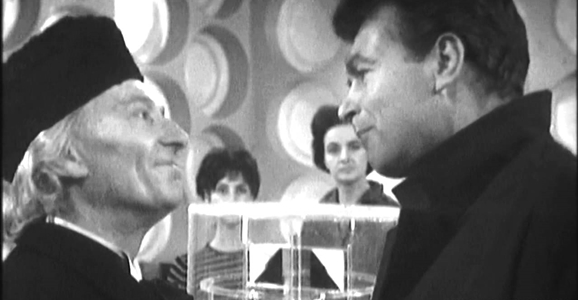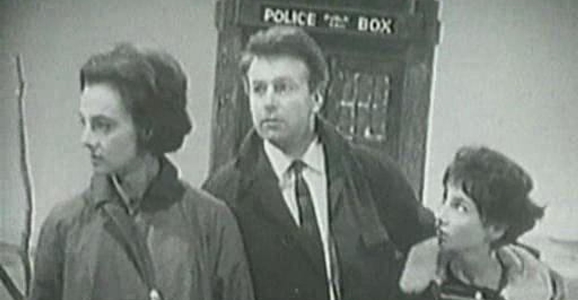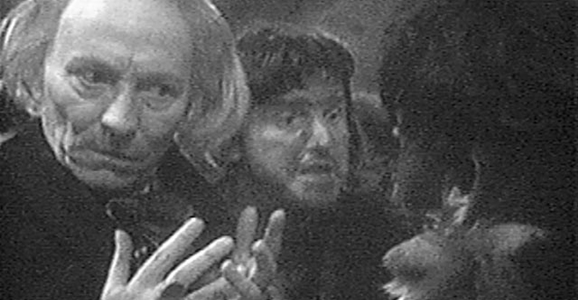A Doctor Who A Day: An Unearthly Child — The Cave of Skulls
He didn't start the fire.
This article is more than 2 years old
 Originally aired November 30, 1963
Originally aired November 30, 1963
When last we left, concerned teachers Ian (William Russell) and Barbara (Jacqueline Hill) barely had time to process the claims that their gifted student Susan (Carole Ann Ford) and her “grandfather” the Doctor (William Hartnell) were time-traveling aliens before the old man threw some switches and shanghaied them off into the time stream. After a bumpy ride, they recover and begin arguing about whether or not they’ve really time traveled or not, an argument that would be a lot briefer if the Doctor would just open the damn doors already.
In the midst of this, we are introduced to a tribe of cave folk, specifically one chap who’s angling for the leadership role. His dad apparently knew how to make with the fire, but neglected to pass the secret on, leaving his poor offspring to frantically play with his bone with nary a spark to show for it. (On the upside, he doesn’t seem to be going blind.)
Once they step outside and find themselves not in London but in a bleak, paleolithic landscape, their disbelief becomes a moot point. While they’re picking up horse skulls and generally gaping in wonder, the Doctor wanders off to have a smoke. Yes, the Doctor smokes a pipe now. Pipes are cool. Unfortunately, the Doctor is soon dragged away by a caveman who saw the Time Lord come out of his “tree” and make fire with his fingers (his matches). So I guess there’s a good lesson for the little ones after all. Don’t smoke or you’ll be kidnapped by a caveman. Stay in school, kids.
The rest of the gang soon realizes the Doctor is AWOL and set off to find him, eventually getting captured as well. And that’s basically it as far as narrative progress for this episode. While the previous ep kept things rolling with the mysteries of who and what the Doctor and Susan are, the leisurely pacing here is a lot more noticeable. Mainly because like half of the episode is spent watching cave people argue about who should be in charge. Indecision 10,000 BC.
We’re left with a cliffhanger that isn’t terribly cliffhang-y, with the TARDIS travelers held captive in a cave full of split-open skulls, thus proving that cave people don’t play when it comes to making fire come from your fingers.

The Good
It’s cool to see all the little elements that will become recurring parts of the show having their very first expression in these early episodes. We get the notion of the Doctor not always having very good control of the TARDIS or knowing where it will take him (in this case, the “year-o-meter” is off). Ian, assuming Susan’s “grandfather” has the same surname she does, calls the old man “Doctor Foreman,” setting Hartnell up to deliver the first of many, many utterances of the words “Doctor Who?”
We also get an explanation for the TARDIS’ permanent appearance as a blue police box, usually making it stick out like a sore thumb during most of the Doctor’s adventures. While they haven’t specifically explained that the “chameleon circuit” is busted, Susan does note that it hasn’t changed appearance and that it was supposed to. It’s a choice no doubt born out of budget practicalities, but it gave us one of the show’s most iconic visuals. Although it does bug me that the exterior of the doors look different from the inside than from the outside. I much prefer the way they eventually stick with the same police box look regardless of whether you’re coming or going.
Once again, I’m loving Hartnell’s Doctor even though I haven’t gotten to know him very well yet. While Hartnell is obviously older than the three most recent “modern” Doctors, he still feels somewhat more “immature” than they do, which makes perfect sense to me. Physical appearance aside, the First Doctor is still comparatively young. He’s arrogant. He’s dismissive. He’s impatient with those flawed little human beings he will eventually come to love and cherish. I can absolutely believe that this character will one day grow into the being played by Christopher Eccleston, David Tennant, and Matt Smith, and that evolution will be fascinating to watch.
It’s also amusing that the Doctor takes along a Geiger counter before heading out. It’s the sort of pragmatic decision you don’t often see in the later Doctors. I guess after surviving nine hundred years of time and space, you get confident enough to just charge into the unknown with naught but a sonic screwdriver, some psychic paper, and some well-earned, damn-the-torpedoes confidence.
Also, whoever came up with the idea for the TARDIS to land slightly askew should get a pat on the back. It’s a little touch of verisimilitude that helps overcome the show’s budget constraints and keep you in the story.

The Bad
I realize we’re only two episodes in, but we get a little character consistency here? Last episode Barbara was naysaying all the Doctor’s impossible claims, while Ian quite sensibly kept pointing out the clearly bigger-on-the-inside TARDIS. One jaunt through time later and all of a sudden their roles are inexplicably reversed. Ian is all “show me proof” and Barbara is in the “open your eyes, dumbass” role. If we could just decide who’s the Mulder and who’s the Scully in this partnership that’d be great, thanks.
Also, as I mentioned, spending so much time watching cavemen argue politics is not exactly the show at its most gripping. Here’s hoping “The Forest of Fear” rallies tomorrow.
Quote of the Day
Ian Chesterton: Just a minute. You say we’ve gone back in time?
The Doctor: Yes, quite so.
Ian Chesterton: So that when we go out of that door, we won’t be in a junkyard in London in England in the year 1963?
The Doctor: That is quite correct. But your tone suggests ridicule.
Ian Chesterton: But it is ridiculous. Time doesn’t go round and round in circles. You can’t get on and off whenever you like in the past or the future.
The Doctor: Really? Where does time go, then?












